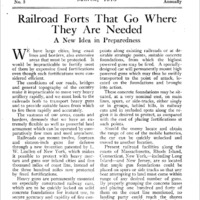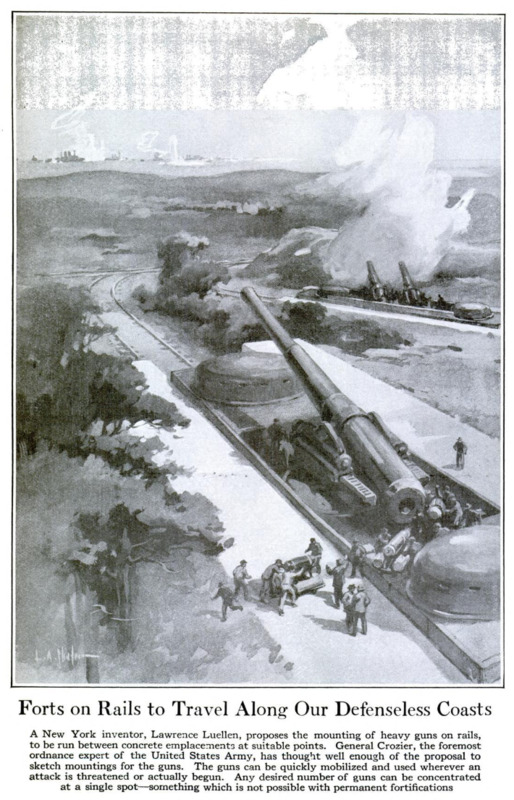-
Title (Dublin Core)
-
Forts on Rails to Travel Along Our Defenseless Coasts
-
Article Title and/or Image Caption (Dublin Core)
-
Forts on Rails to Travel Along Our Defenseless Coasts
-
extracted text (Extract Text)
-
WE have large cities, long coast
lines and borders, also extensive
areas that must be protected. It
would be impracticable to fortify most
of them by expensive fixed fortifications
even though such fortifications were con-
dered efficient
The conditions of our roads, bridges
and general topography of the country
make it impracticable to move very heavy
artillery rapidly, and we must look to the
railroads both To transport heavy guns
and to provide suitable bases fron which
to fire them rapidly and accurately.
The vastness of our areas, coasts and
borders, demands that we have an ex-
tremely flexible as well as powerful land
armament which can be operated by com-
paratively few men and used anywhere.
Railroads can mount twelve, fourteen
and sixteen-inch guns for defense
through a new invention patented by I.
W. Lucllen of New York, which makes
it possible to protect with heavy mor-
tars and guns our inland cities and five
thousand miles of coast line, instead of
the three hundred miles now protected
by fixed fortifications.
Heavy guns are permanently mounted
on expecially constructed Railway ars
which are to be quickly locked on solid
concrete foundations for instant use, to
secure accuracy and rapidity of fire con-
trol. These mobile armament cars are
designed to utilize the present coast and
inland railways to protect our seaboard,
thus increasing the flexibility and stra’
tegic value of high-power guns such as
are now mounted on fised foundations.
Mr. Luellen would install at fixed
points along existing railroads or at de-
sirable strategic points, suitable concrete
foundations, from which the highest
powered guns may be fired. A specially
designed car will permanently mount high
powered guns which may thus be swiftly
transported to the point of attack, lo-
cated on the foundations and brought
into action.
These concrete foundations may be sit-
uated, at a very nominal cost, on main
lines, spurs, or side-tracks, either singly
or in groups, behind hills, in railway
cuts and in secluded spots along the re-
ion i is desired to protect, as compared
with the cost of placing fortifications at
such points.
Should the enemy locate and obtain
the range of one of the mobile batteries,
the car can be quickly unlocked and
moved to another location.
Present railroad facilities along the
coasts of Massachusetts, Rhode Island,
Connecticut, New York including Long
Wand—und New Jercy, ae so fot
that ample. gun. foundations could he
placed on spurs or side tracks so that any
boat attempting to land must come within
range of any desired number of guns.
By properly grouping the concrete bases
and placing one hundred and forty of
them on the coast line mentioned, no
landing party could reach the shores
without coming within the deadly nine-
mile range of six mortars.
These concrete bases would cost ap-
proximately three thousand to four thou-
sand dollars each—total cost of one hun-
dred and forty bases, including labor,
about five hundred ‘thousand dollars,
‘The mortar armament cars should be
located at stations along the coast, where,
upon an hour's notice, several of them
could be moved into position for action,
It is estimated that to cover this shore
line would require in the neighborhood
of fifty mortars and ten rifle armament
cars, This would mean that there would
he one hundred and ten guns on mobile
car equipment with total outlay (esti-
mating the car and guns to cost one hun-
dred and fifty thousand dollars) about
nine million dollars,
Approximately twenty to twenty-five
men would be required per car, Thus, for
the cost of one modern battleship, we
not know. Mr. Luellen has made a dis-
tinct contribution in suggesting concrete
emplacements.
-
Contributor (Dublin Core)
-
Lawrence Luellen (inventor)
-
Language (Dublin Core)
-
eng
-
Date Issued (Dublin Core)
-
1916-03
-
pages (Bibliographic Ontology)
-
322
-
Rights (Dublin Core)
-
Public Domain (Google digitized)
-
Archived by (Dublin Core)
-
Filippo Valle
-
Alberto Bordignon (Supervisor)
 Popular Science Monthly, v. 88, n. 3, 1916
Popular Science Monthly, v. 88, n. 3, 1916



